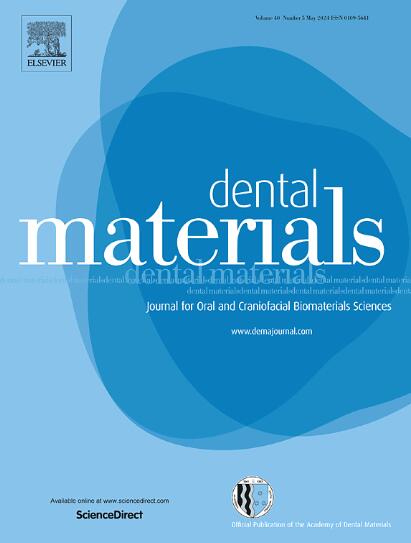牙科粘合剂单体 10-MDP 的合成与表征。
IF 4.6
1区 医学
Q1 DENTISTRY, ORAL SURGERY & MEDICINE
引用次数: 0
摘要
许多研究已经证明,10-MDP(10-甲基丙烯酰氧癸基磷酸二氢酯)作为牙科粘合材料的功能单体和陶瓷表面的底漆,具有卓越的性能。尽管 10-MDP 的纯度会影响粘合剂的性能,但很少有人对这一参数进行描述,文献中也提出了可能存在的副产品,但迄今为止尚未发现。本研究旨在利用易于处理的试剂提出一种简便的 10-MDP 合成策略,并解决表征方面的难题,尤其是在确定副产品方面。10-MDP 是由甲基丙烯酸 10- 羟基癸酯和五氧化二磷在丙酮中合成的。核磁共振(NMR)、红外光谱(FTIR)和质谱 MALDITOF/TOF 对最终产品进行了表征。通过 1H、31P 和 13C 核磁共振分析,确定了与 10-MDP 相关的主要化学基团。只有质谱分析(MALDITOF/TOF)能确定二聚物作为副产品的存在。其拟议的化学结构表明,二聚体是由磷酸酯基团和其他由 10-MDP 分子的甲基丙烯酸基团反应形成的。研究还描述了为减少这些副产物的形成而对合成条件进行的精心调整。结果表明,对作为原材料的 10-MDP 批次进行鉴定是一项重要任务,因为根据存在的副产品,其聚合能力或酸蚀刻能力可能会受到影响。本文章由计算机程序翻译,如有差异,请以英文原文为准。
Synthesis and characterization of the dental adhesive monomer 10-MDP
Many studies have demonstrated the excellent performance of 10-MDP (10-methacryloyloxydecyl dihydrogen phosphate) as a functional monomer for dental adhesive materials and as a primer for ceramic surfaces. Although adhesive performance is affected by the purity level of 10-MDP, this parameter is rarely described, and possible byproducts have been suggested in the literature, but have not been identified to date. The present study aims to present an accessible 10-MDP synthesis strategy with easily handled reagents and address the characterization challenges, especially in identifying byproducts. 10-MDP was synthesized from 10-hydroxydecyl methacrylate and phosphorus pentoxide in acetone. The final product was characterized by nuclear magnetic resonance (NMR), infrared spectroscopy (FTIR) and mass spectrometry MALDITOF/TOF. The main chemical groups associated with 10-MDP were identified by 1H, 31P, and 13C NMR analyses. Only mass spectrometry analyses (MALDITOF/TOF) could identify the presence of dimers as byproducts. Its proposed chemical structure indicates that the dimers were formed by the reaction between the phosphate ester groups and others formed by the reaction of the methacrylic group of 10-MDP molecules. Careful adjustment of the synthesis conditions to reduce the formation of these byproducts is also described. The results indicate that the characterization of 10-MDP batches as raw materials is an important task because, depending on the byproduct present, its ability to polymerize or acid etching capacity may be compromised.
求助全文
通过发布文献求助,成功后即可免费获取论文全文。
去求助
来源期刊

Dental Materials
工程技术-材料科学:生物材料
CiteScore
9.80
自引率
10.00%
发文量
290
审稿时长
67 days
期刊介绍:
Dental Materials publishes original research, review articles, and short communications.
Academy of Dental Materials members click here to register for free access to Dental Materials online.
The principal aim of Dental Materials is to promote rapid communication of scientific information between academia, industry, and the dental practitioner. Original Manuscripts on clinical and laboratory research of basic and applied character which focus on the properties or performance of dental materials or the reaction of host tissues to materials are given priority publication. Other acceptable topics include application technology in clinical dentistry and dental laboratory technology.
Comprehensive reviews and editorial commentaries on pertinent subjects will be considered.
 求助内容:
求助内容: 应助结果提醒方式:
应助结果提醒方式:


